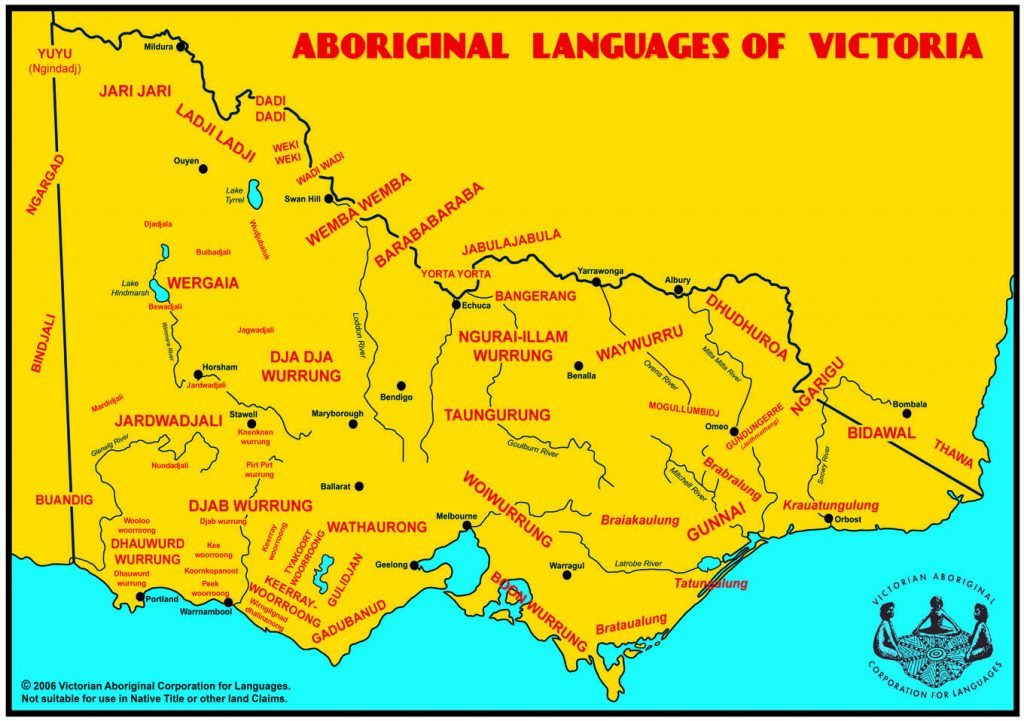Victorian Aboriginal and Torres Strait Islander Demographics
As of the 2016 Census, there were 47,788 Aboriginal and/or Torres Strait Islander people in Victoria, making up 0.8 per cent of the population. The median age for Aboriginal and/or Torres Strait Islander Victorians is 23, compared to 37 for other Victorians. 1
Approximately 54 per cent of Aboriginal and/or Torres Strait Islander Victorians live in regional areas while 46 per cent live in metropolitan areas. Over 51% of the Victorian Aboriginal and/or Torres Strait Islander population live in one of fifteen local government areas. The Local Government Areas with the highest Aboriginal and Torres Strait Islander populations are: Shepparton; Mildura; Geelong; Bendigo; Casey; East Gippsland; Darebin; Wyndham; Ballarat; Whittlesea; Latrobe; and Hume. 2
Victorian Aboriginal and Torres Strait Islander Languages
Before colonisation there were approximately 39 languages spoken across the area that is now Victoria. Language is a large part of Aboriginal and Torres Strait Islander culture and strengthens ties between Elders and young people and improves connection to culture and Country. The boundaries between Victorian Aboriginal and/or Torres Strait Islander language areas are not distinct and mixtures of vocabulary and grammar exist in some regions, therefore linguistic maps may show some variation about where one language ends and another begins. 3
Map of Victorian Aboriginal Languages

See more at Aboriginal language map of Victoria.
The use of Aboriginal and Torres Strait Islander English is an aspect of contemporary Aboriginal and Torres Strait Islander culture. Users of Aboriginal and Torres Strait Islander English are making a statement about identity. Valuing and respecting someone’s use of Aboriginal and Torres Strait Islander English indicates to them that you value them, their Aboriginality and their history. 4 Here are some examples of common words used in Victoria:
| Aboriginal and Torres Strait Islander English | Standard Australian English |
|---|---|
| mob | group |
| sorry business | ceremony associated with death |
| gammon | kidding, joking, pretending |
| deadly | really good |
Sorry Business – Bereavement and Funerals
Aboriginal and Torres Strait Islander people refer to the period of mourning when an Aboriginal and/or Torres Strait Islander person dies as ‘Sorry Business’. It is an important period for Aboriginal and Torres Strait Islander people and involves responsibilities and obligations to attend funerals and participate in other cultural events, activities or ceremonies.
In some Aboriginal and Torres Strait Islander communities, the extent of obligations to participate in Sorry Business related to bereavement is dictated by the status of the deceased person and a person’s kinship to them. It is very important to recognise that in many communities, there is an expectation that funerals involve the whole community and not just the immediate family and friends. Assumptions should not be made about the presumed ‘closeness’ or relationship of a person to the deceased in appreciating the necessity of their participation in Sorry Business. 4
In a workplace, managers need to be aware that an Aboriginal and/or Torres Strait Islander worker will need to take time out to attend funerals, often to pay respects on behalf of their family or take extended periods of time off for Sorry Business when a family member has passed away.
‘Men’s business’ and ‘women’s business’
‘Men’s business’ and ‘women’s business’ remain very important and sensitive issues within Aboriginal and Torres Strait Islander culture. Some information should only be talked about or negotiated and consulted on by people of the relevant gender. Information relating to ‘women’s business’ should be stored in such a way that only women have access to it, and information that is ‘men’s business’ stored in such a way that only men have access to it.
As such, when conducting research or consultation, it is important to plan ahead as to whether you will need both male and female researchers, consultants or project workers, in the event that matters concerning men’s or women’s business may be raised. 4
In a workplace a manager needs to be aware that, for example, a female Aboriginal and/or Torres Strait Islander employee may be less inclined to open up to a male manager than if it was a female manager and vice versa.
Contemporary Aboriginal and Torres Strait Islander Culture is Thriving
Despite the enormous odds presented by colonisation, forced removal, discrimination and injustice, Aboriginal and Torres Strait Islander communities and cultures are thriving: strong kinship ties and social obligations continue; cultural centres, Aboriginal and Torres Strait Islander art, film, dance and theatre and activities celebrating Aboriginal and Torres Strait Islander cultures and significant events demonstrate the resilience of Aboriginal and Torres Strait Islander communities and cultures. 5
Questions for managers and workplaces:
- Have you and your staff attended cultural awareness training?
- Do you know where you can access information regarding who the Traditional Owners are and local Aboriginal and Torres Strait Islander history?
- Do you understand the ongoing impact of past government policies and practices on Aboriginal and Torres Strait Islander people?
- Do you understand that an Aboriginal and/or Torres Strait Islander employee working for you may have family obligations that may have an impact on work?
- Does your workplace display the Aboriginal and Torres Strait Islander Flags?
- Are you and your staff aware of and able to talk about the history of the flags?
- Do you understand ‘Sorry Business’ and how it impacts an Aboriginal and/or Torres Strait Islander worker?
- Do you understand how men’s and women’s business may have an impact on the relationship with Aboriginal and Torres Strait Islander employees working for you?
Useful links and other information
Further information on Aboriginal cultural heritage of Victoria
Further information on Aboriginal culture
For further information on Aboriginal languages
- Source: Australian Bureau of Statistics, 2016
- Source: Australian Bureau of Statistics, 2011
- Source: VACL Language Map of Victoria
- Source: Working and Walking Together: Supporting Family Relationship Services to Work with Aboriginal and Torres Strait Islander Families and Organisations
- Source: VACCA Building Respectful Partnerships 2010
